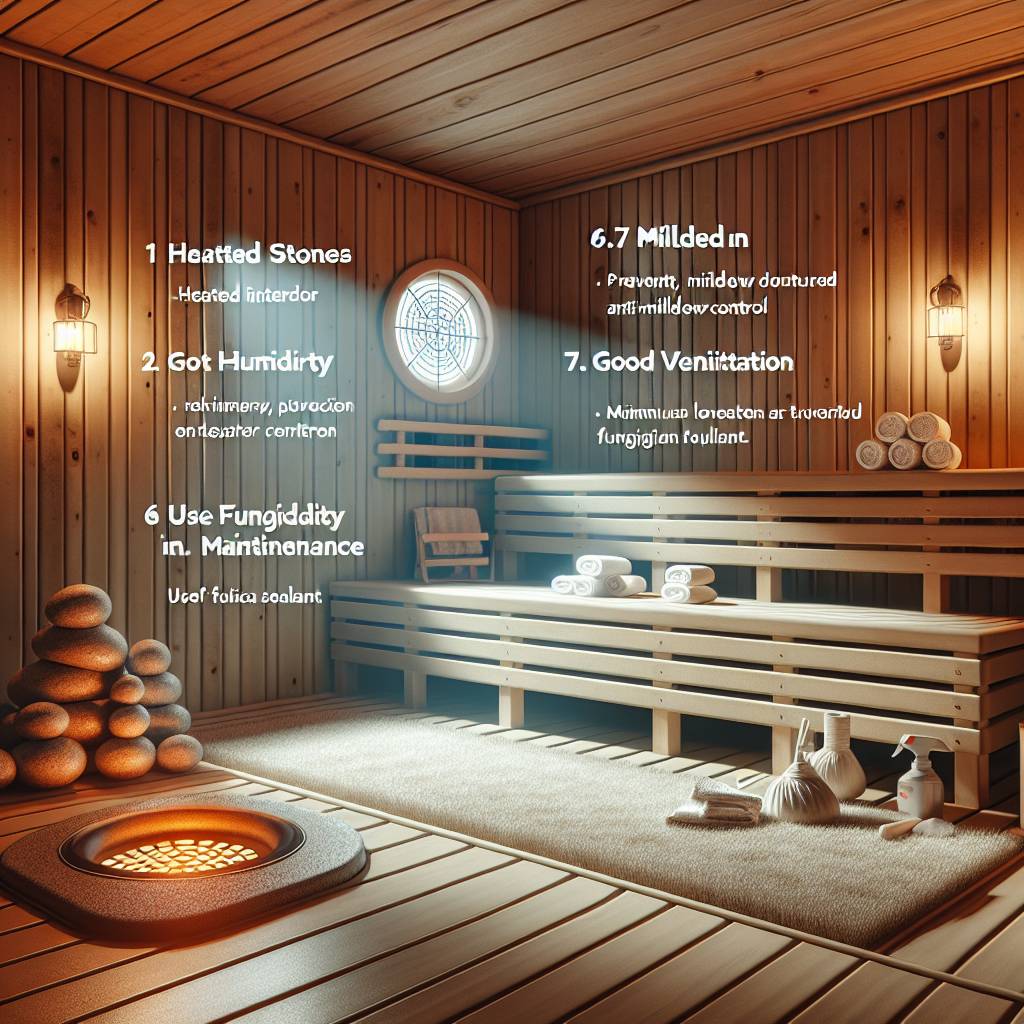Discover effective strategies to keep mold at bay in your sauna. Mold growth can thrive in warm, damp environments, posing health risks and damaging your sauna’s structure. Learn how to combat this issue with simple preventative measures. From proper ventilation techniques to regular cleaning routines, you can safeguard your sauna against mold infestations. Explore the contrast between a mold-free oasis and a breeding ground for fungi. Implement these tips to maintain a clean, safe, and enjoyable sauna experience.
Key Takeaways
- Regularly inspect your sauna for any signs of mold growth to address the issue promptly.
- Maintain proper ventilation in your sauna to prevent moisture buildup, a key factor in mold growth.
- Establish a consistent cleaning routine using appropriate products to keep mold at bay.
- Consider using mold-resistant materials when building or renovating your sauna to reduce the risk of mold growth.
- Monitor humidity levels and ensure effective drainage to create an environment inhospitable to mold.
- Implement advanced prevention techniques like UV lights or dehumidifiers for added protection against mold.
Understanding Sauna Mold
Mold Concerns
Mold concerns in saunas are prevalent due to the high humidity and warmth, creating an ideal environment for sauna mold growth. The most common mold found in saunas is sauna fungus, thriving on wood surfaces. To prevent mold, it is crucial to maintain clean sauna conditions and proper ventilation.
Prevention Basics
Importance of ventilation
Proper ventilation plays a crucial role in preventing mold growth in saunas. Adequate airflow helps in controlling moisture levels, reducing the risk of mold formation. Without proper ventilation, saunas can become breeding grounds for mold due to trapped humidity.
Ventilation systems circulate air, removing excess moisture that could lead to mold. Fresh air intake and exhaust fans are essential components for maintaining optimal sauna conditions. Regularly opening windows also aids in promoting air circulation, preventing mold from thriving in the damp environment.
Regular cleaning benefits
Consistent cleaning routines are key to preventing mold growth in saunas. Regular cleaning helps eliminate any existing mold spores, preventing them from spreading and multiplying. By maintaining cleanliness, sauna owners can create an inhospitable environment for mold to thrive.
Cleaning surfaces with mild detergent and water can effectively remove dirt and grime, reducing the chances of mold development. Wiping down benches and walls after each use can prevent moisture buildup, further inhibiting mold growth. regular inspections for any signs of mold or mildew are essential for early detection and prevention.
Interior Treatment
Avoid paint and varnish
When preventing mold in saunas, it’s crucial to avoid painting and varnishing the interior surfaces. Paint and varnish can trap moisture, creating a perfect environment for mold growth. Sauna wood needs to breathe naturally to prevent moisture buildup.
Paint and varnish create a barrier that prevents the wood from releasing moisture, leading to condensation and mold formation. Unsealed wood surfaces allow for proper ventilation, reducing the chances of mold development.
- Pros:
- Allows natural ventilation
- Prevents moisture buildup
- Cons:
- May require more frequent maintenance
Treatment exceptions
In certain cases, treating specific sauna parts with varnish is acceptable. When areas are prone to dirt buildup, treating them can aid in maintenance by making cleaning easier. However, it’s crucial to balance treatment exceptions with overall sauna maintenance practices.
Treating high-contact areas like benches or floors with varnish can help protect the wood from wear and tear. Regular cleaning of these treated areas is essential to prevent dirt accumulation that could lead to mold growth.
- Key Points:
- Treat high-contact areas
- Regularly clean treated surfaces
Cleaning Routine Development
Establish routine
Establishing a regular cleaning routine is crucial for maintaining a mold-free sauna environment. By consistently cleaning your sauna, you can prevent mold growth and ensure a healthy space for relaxation. To create a practical cleaning schedule, start by setting specific days each week for sauna maintenance.
A consistent cleaning schedule offers several benefits, including preventing mold and mildew buildup, extending the lifespan of your sauna, and maintaining optimal air quality. By dedicating time to clean your sauna regularly, you can enjoy a hygienic and inviting space for relaxation.
To develop an effective cleaning routine, consider incorporating tasks such as wiping down surfaces after each use, deep cleaning weekly with gentle products, and inspecting for any signs of mold growth. By following these steps diligently, you can ensure that your sauna remains mold-free and in top condition.
Cleaning essentials
When it comes to sauna maintenance, having the right cleaning tools and products is essential. Some essential items for sauna cleaning include a soft brush or cloth for wiping down surfaces, a gentle wood cleaner specifically designed for saunas, and a bucket of warm water mixed with mild soap.
Using gentle cleaning methods is crucial to preserve the integrity of the sauna wood. Harsh chemicals can damage the wood surface and lead to mold growth. Opt for natural cleaners or those specifically formulated for sauna use to ensure that your sauna remains in pristine condition.
Choosing the right cleaning essentials for your sauna involves selecting products that are safe for both the users and the environment. Look for non-toxic, eco-friendly options that are effective in removing dirt and preventing mold without compromising the quality of the wood.
Ventilation Strategies
Promote airflow
To prevent mold growth in saunas, promoting airflow is crucial. By ensuring proper ventilation, you can reduce moisture buildup. Good airflow helps in maintaining a dry environment, minimizing the conditions favorable for mold to thrive. Implementing strategies such as installing vents or fans can significantly improve air circulation within the sauna.
Moreover, good airflow not only aids in preventing mold but also enhances the overall sauna experience. It helps in regulating temperature and humidity levels, creating a more comfortable environment for users. By optimizing ventilation, you can enjoy a healthier and more enjoyable sauna session while keeping mold at bay.
For optimizing ventilation, consider installing adjustable vents that allow you to control the airflow based on your preferences. Regularly check and clean these vents to ensure they are free from any blockages. Using a dehumidifier can help in reducing excess moisture in the air, further enhancing the effectiveness of your ventilation system.
Open-door policy
Implementing an open-door policy after using the sauna is a simple yet effective way to prevent mold growth. Leaving the sauna door open allows excess moisture to escape, preventing it from being trapped inside the sauna. This practice helps in drying out any residual moisture, reducing the likelihood of mold formation.
An open-door policy also promotes air circulation, aiding in the evaporation of sweat and moisture present in the sauna. By allowing fresh air to flow into the sauna space, you create an environment less conducive to mold growth. Remember to leave the door open for a sufficient amount of time after each use to ensure proper ventilation.
To effectively implement an open-door policy for mold prevention, establish clear guidelines for sauna users. Encourage them to leave the door open for a specific duration after each session. Educate users on the importance of this practice in maintaining a clean and mold-free sauna environment.
Drainage and Humidity Control
Drainage maintenance
Proper drainage maintenance is crucial in saunas to prevent mold growth. Stagnant moisture from sweat can lead to mold issues. Ensure adequate drainage to avoid moisture buildup.
Ineffective drainage can create ideal conditions for mold to thrive, especially in areas where moisture accumulates. Regularly clean drains and remove any blockages to prevent mold development.
To prevent mold concerns, regularly inspect and maintain sauna drains. Consider installing drain covers to prevent clogs and ensure smooth water flow.
Humidity management
Humidity control is key in preventing mold in saunas. High humidity levels can promote mold growth. Maintain humidity levels between 10-15% in saunas for optimal conditions.
Excessive humidity can create a breeding ground for mold. Use a hygrometer to monitor humidity levels regularly and adjust ventilation accordingly.
To manage humidity effectively, consider using dehumidifiers in saunas to reduce moisture content in the air. Proper ventilation strategies, as discussed earlier, also play a crucial role in maintaining ideal humidity levels.
Material Choices
Benefits of Cedar
Using cedar wood in sauna construction offers numerous benefits. Cedar naturally resists mold and mildew, making it an excellent choice for preventing mold growth. Its natural properties help maintain a clean and healthy sauna environment. Cedar’s aromatic scent enhances the overall sauna experience, providing a soothing and relaxing atmosphere.
When it comes to sauna longevity, cedar wood stands out as a preferred material. Its durability and resistance to decay ensure that the sauna structure remains intact over time. The natural oils present in cedar act as a protective barrier against moisture, further preventing mold formation. Opting for cedar in sauna construction not only ensures longevity but also adds aesthetic appeal to the space.
Material Considerations
When considering materials for sauna construction, it is crucial to understand their impact on mold prevention. Different materials have varying levels of resistance to mold growth. Selecting materials such as cedar, redwood, or hemlock can significantly reduce the risk of mold formation in saunas. These woods possess natural properties that inhibit mold and mildew, promoting a healthier sauna environment.
Choosing suitable materials is essential for ensuring the longevity of saunas. Materials that are resistant to moisture and humidity play a vital role in preventing mold growth. Avoiding materials prone to rotting or decay is key to maintaining a mold-free sauna environment. By selecting high-quality, mold-resistant materials, individuals can enjoy their saunas for years to come without worrying about mold issues.
Advanced Prevention Tips
Last Resorts
When mold issues persist in saunas despite regular cleaning, consider last-resort measures. Bleach is a potent mold remover. Dilute it and apply directly to affected areas. Essential oils like tea tree or lavender can also combat mold effectively.
To address severe mold problems as a final solution, consider a thorough sauna renovation. Replace damaged wood, insulation, or any other affected materials. Ensure proper ventilation and monitor humidity levels regularly.
Professional Assessments
Seeking professional assessments for severe mold cases is crucial. Experts possess the knowledge and tools to identify mold types accurately. They can recommend effective solutions to eradicate mold growth permanently.
Professionals bring invaluable expertise in resolving mold issues efficiently. Their thorough inspections ensure all hidden mold sources are detected and eliminated. Consult experts when faced with persistent or extensive mold problems in saunas.
Summary
You’ve now gained a comprehensive understanding of sauna mold prevention strategies. By implementing the basics, focusing on interior treatments, developing a consistent cleaning routine, optimizing ventilation, controlling humidity and drainage, selecting suitable materials, and incorporating advanced tips, you can effectively combat mold growth in your sauna. Remember, mold prevention is not a one-time task but an ongoing process that requires diligence and attention to detail. By following these guidelines and staying proactive, you can ensure a mold-free and enjoyable sauna experience for years to come.
Take action now by applying these tips to your sauna maintenance routine. Regularly check for any signs of mold, address them promptly using the methods discussed, and stay proactive in preventing mold growth. Your efforts will not only preserve the integrity of your sauna but also contribute to a healthier and more pleasant environment for you and your guests. Stay vigilant and enjoy your mold-free sauna!
Frequently Asked Questions
How does mold develop in saunas?
Mold thrives in warm, moist environments like saunas due to high humidity levels and lack of ventilation. Without proper maintenance, mold spores can easily grow on surfaces such as wood, walls, and ceilings.
What are the key prevention basics for mold in saunas?
To prevent mold in saunas, ensure proper ventilation, control humidity levels, regularly clean and dry sauna surfaces, use mold-resistant materials, and monitor for any signs of mold growth.
Why is interior treatment important for mold prevention in saunas?
Interior treatment involves using mold-resistant paint or sealant on sauna surfaces to create a barrier against moisture and mold growth. This step is crucial in maintaining a mold-free environment within the sauna.
How can I develop an effective cleaning routine for mold prevention in saunas?
Establish a regular cleaning schedule that includes wiping down surfaces after each use, using a mildew cleaner weekly, and deep cleaning monthly. Consistent maintenance will help prevent mold from taking hold in the sauna.
What ventilation strategies are effective for preventing mold in saunas?
Proper ventilation is key to preventing mold in saunas. Install vents or fans to circulate air, keep the sauna door slightly ajar when not in use, and consider using a dehumidifier to maintain optimal humidity levels.






